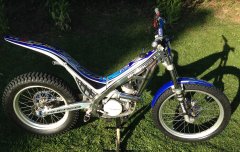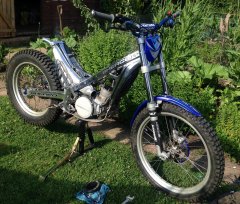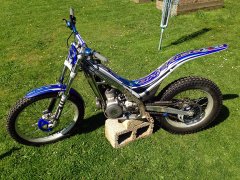-
Posts
62 -
Joined
-
Last visited
Contact Information
-
Thank Tony, that does explain it better - I hadn't thought of them acting to help the seal. In the end, having well and truly jammed the new bush, I used a jab saw to cut along the gap. The bush then fitted a lot better and I used a needle file to widen the other ones. Also got some 40mm plastic pipe which worked brilliantly to push everything into the forks. So far there's been no sign of oil leaks and the real test will be next time I get to a trial. Moral of the story would be not to force things if they don't fit. But sometimes it's hard to know how much force you should use. ?
-
Hi, I've not done much for 8 months or so, because the last time i was out the forks started leaking and needed some work. Having taken them apart, the advice was to replace the stanchion bushes as they are well worn. Now I've finally got the replacement bushes, but having just reread the tips on Splatshop, it turns out I need to widen the gap in them BEFORE ramming them in the fork case!!! Unfortunately, I've already trashed one set trying to get them in and now one of the bushes is so badly forced into the leg I can't begin to shift it to get it out again. (and the lower bush has popped off the stanchion tube) How can i go about removing the bush without ruining my forks, and how do i accurately resize the bushes to fit? ? How accurate do the bushes need to be if I widen the gap in them? Any advice would be really appreciated - I'm desperate to get the bike going again....
-
How long would you expect the oil seals to last normally? The bike's had pretty light use over the past year and a half. But it was a hot day, 30c+ when I noticed them give.
-
Ourin, that is the guide I'm using. Ok halfway down may have been an exaggeration, as deep as the plastic spacer that I used to push it in with. But I did get the metal ring out of the upper tube using an axle with a bolt on the end. It seems the top spacer fits in with the metal ring on top but not the other way (as the guide has it) - have I got it wrong or is the guide inaccurate? The diagram on Page 2 doesn't look quite right either - the plunger rod sit underneath the spring and not through it as the image suggests. Oh well, got forks back on and they're still weeping, so better order new seals and do it all again
-
Hi all, Run into a problem last weekend when cleaning up and rebuilding my forks - the first time I put the spacer in above the spring it jams in the leg!? All I can think is it's been lying in parts for a few weeks now and likely something has expanded/contracted in that time. On the last trial I noticed the forks weeping and got really soft (it was over 30c that day). So decided it was time for a rebuild and examine. The seals were relatively new, as was the oil just before I bought the bike. But when I opened them up the oil looked like it had almost split. There was gunk and almost crystallised bits around the seals. Following the RYP ShercoUSA guide, I pulled them apart and ordered new oil. It stayed really hot for a few weeks, so they sat there draining. Eventually I cleaned the parts up, but noticed when I replaced the plastic spacer on top of the spring it was stiff. Now I've jammed the metal ring from the bottom of the spacer half way down inside the leg trying to push the spacer in! How the hell do I get it out without either damaging the fork or the spacer ring? And how do I get it back in if it's expanded?? Any thoughts much appreciated as always
-
bluegnu changed their profile photo
-
Got mine on ebay for £30, though the bike doesn't have the wiring for it and I don't have the bar switch either (which is harder to find second hand), so it's only for looks. Bulb spec and light kit on splatshop: http://www.splatshop.co.uk/catalogsearch/advanced/result/?sherco_part_code=C067 I use a medium powered bicycle light that you can strap to the bars such as the Lezyne, does the job.
-
Is it likely to be damaging on a 250cc engine do you think? It doesn't appear to be an insert, more like the whole neck is narrow. Here's what the two exhausts look like side by side - my old 2.5 exhaust (left) and the narrow on the right:
-
I finally lifted the cylinder head and it wasn't as bad as I'd feared (pictures below) The piston and head were completely caked in carbon, so obviously hadn't been open for a very long time, but once cleaned off didn't look bad at all. It's probably the original piston! It looks like it's taking in too much fuel judging by the residue in the cylinder and on the spark plug?
-
I had similar problems on my very old Sherco sometimes taking ten+ kicks starting, sometimes not and the throttle being tetchy, backfiring, overheating etc. Was worried the stator had gone, but eventually pulled the flywheel after advice here (tenner for the flywheel puller), the woodruff key had completely sheared - a couple of quid from Splatshop. It's and easy job if you have the tools
-
Can anyone tell me why the exhaust header pipe I just got on a well-known auction site has a narrow neck where it joins the cylinder? First I thought it was from a smaller CC, but looking at other ones online I've seen them advertised from the 290cc. My bike goes well with it on but will it overheat?
-
Thanks for the encouragement and guidance. I've not had time or courage to tackle taking it apart yet... For the most part she's running well and the slow action throttle makes a hell of a difference. What is strange is starting from cold with choke is often first quick, but restarting when hot can be a bugger and take many kicks with throttle open! I also found the intermittent fan was down to a loose connection between the thermostat (now bypassed) Maybe tackle the cylinder this weekend, cautious about causing more harm than good.
-
I'm still unsure about some engine tapping/rattle. Starting it is a lot better since replacing the stator, also a lot less unpredictable on the throttle I think (unless I'm just getting used to it) I'd like to get the cylinder off to see what condition the piston is in - but if I get in there, wondering if I should replace piston rings as a matter of course. Or, if the piston is looking badly worn, am I better off just saving for the piston kit? I imagine if there's not too much play in the piston I might get away with a top end bearing and rings. How frequently do these things need doing, on a bike of this age, depending how hard it's been ridden? In the meantime, going to swap for a Slow Action throttle because it is far too sensitive...
-
Does the engine sound noisy - a bit of rattle?









.jpg.f86b6f4ab894cdc023b6898812adeb86.jpg)
